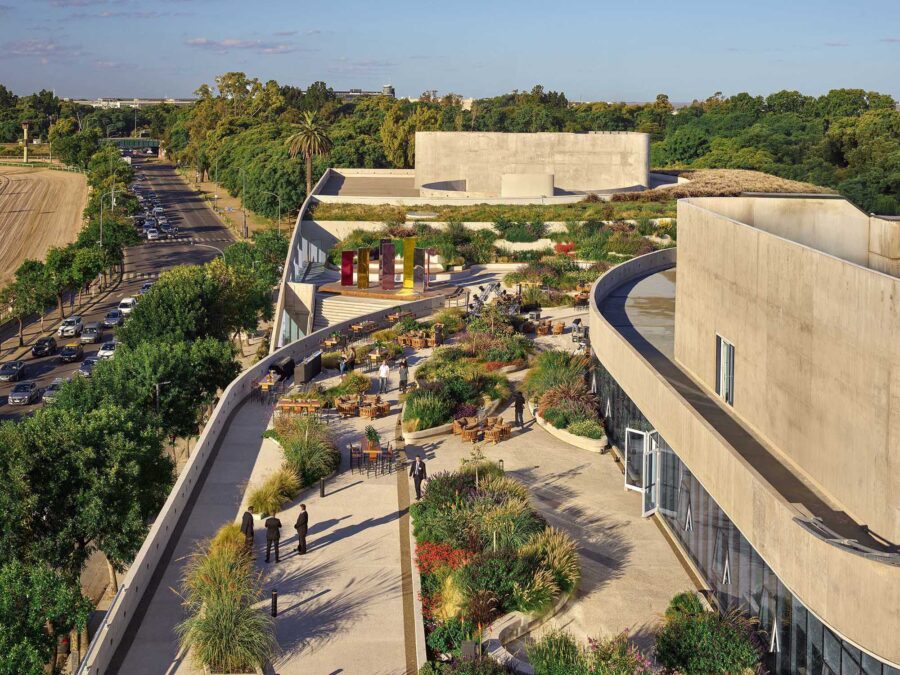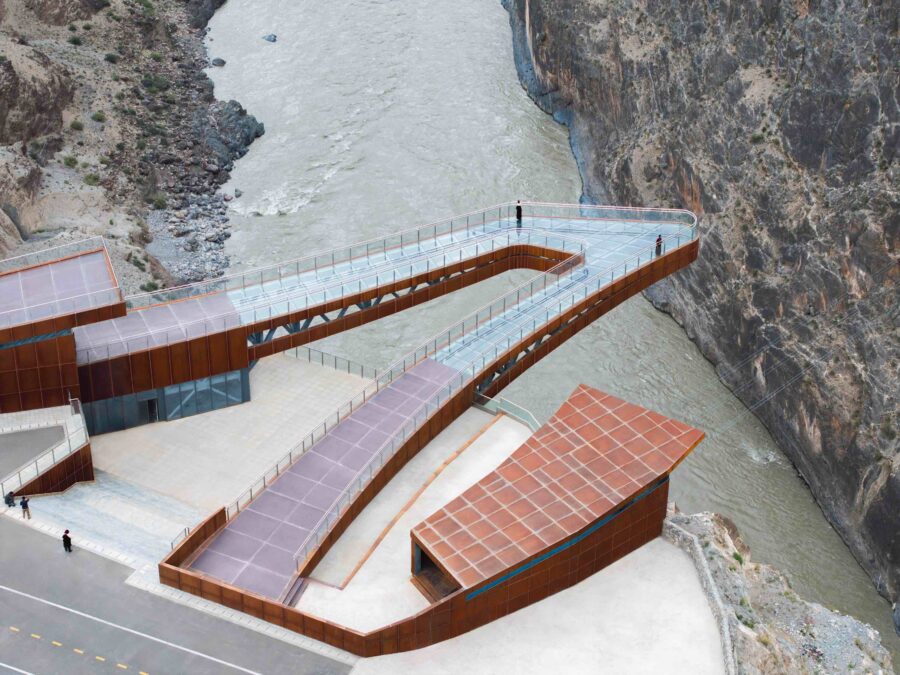
CULTURE


©︎ Hemant Patil, a for architecture

©︎ Hemant Patil, a for architecture
〈ヴィヴェダ・ウェルネス・ビレッジ(Viveda Wellness Village)〉は、インドのマハラシュトラ州にあるセラピー、デトックス、ヨガといったさまざまなアクティビティや宿泊機能をもった総合ウェルネス施設です。
インドの設計事務所a for architectureが設計した、地域の伝統的な家屋や歴史的な建造物の要素を取り入れた、ヴァナキュラーでありながら新たな体験を生み出す建築です。
(以下、a for architectureから提供されたテキストの抄訳)

©︎ Hemant Patil, a for architecture
高温で乾燥した環境に対応するパッシブクーリング
この敷地の最も特徴的な要素の1つに、その豊かな環境がある。広大なサヒャドリ山脈と、魅惑的な水をたたえるガウタミ・ゴダバリ・ダムの間に位置し、さまざまな色合いの農地、散りばめられた木々、牛や羊といった動物が暮らす風景がモザイク状に広がっている。

©︎ Hemant Patil, a for architecture
この地域は、特に夏場は暑く乾燥した気候だが、モンスーンや冬は快適な気候を楽しむことができる。このような環境に対応した空間とすることを第一に考え設計を行った。
建物の大部分は、最小限の壁により日陰・自然光・風通しを最大限に確保するように設計されている。また、すべての建物に中庭とグリーンポケットを設けることで、通気性を良くし、気温を下げ、適度な湿度を加えている。

©︎ Hemant Patil, a for architecture
地域の文化と結びつく建物のマテリアル
このプロジェクトで次に主眼をおいたのが、建物が位置するベゼ村とその周辺の集落における建築様式を理解し、取り入れることであった。一般的にこの地域の家屋は、石造りの土台、木材の骨組み、レンガや泥の壁、屋根にはクレイポットタイルを使用している。
また、この地域における建築行為は他の多くの活動と同様に、スキル、労働力、資源を相互に交換するという、共同体としての一連の活動と考えられている。例えば、石工が農民のために家を建てると、農民は石工に穀物や他のスキルを提供することで報酬を支払っている。

©︎ Hemant Patil, a for architecture
敷地は人里離れた場所にあるため、コンクリートや鉄の使用は最小限に抑え、地元の材料である玄武岩の石材、木材のフレーム、ポットタイルの屋根という3つの材料で構成されている。この試みは、これらの素材を扱う伝統的な技術を持つ地元の職人と協力することで実現した。
すべての材料は地元(20〜50km圏内)で調達され、環境への負荷を低減している。

©︎ Hemant Patil, a for architecture
空間の重厚感をつくり出す石材
石材加工は、主にワダリ(Wadari)と呼ばれるコミュニティによって行われた。ワダリは、特にインドのマハラシュトラ州やカルナータカ州北部に住む石工の専門としたコミュニティで、農村経済において重要な存在である。
この地域で豊富に採れる玄武岩は、石工たちの手によって採石され、現場で刻まれ施工された。玄武岩を耐力壁、階段、中庭、ランドスケープなど、多くの部分で採用することにより、風景の中にそっとたたずむ、モノリシックな建物として表現した。

©︎ Hemant Patil, a for architecture

©︎ Hemant Patil, a for architecture

©︎ Hemant Patil, a for architecture
地域の歴史を引き継ぐ新旧の木材
このプロジェクトでは、2種類の木材を使用している。
ハラドゥ(Haladu):黄色い色調の木材であり、主に屋根の構造や柱に使用されている。
アップサイクルウッド:地域の100以上の老朽化した建物から引き取ったインドのチーク材。主に地元の大工が担当し、スータと呼ばれる大工職人が代々その技術を受け継いでいる。

Wooden Joinery Detail

©︎ Hemant Patil, a for architecture

©︎ Hemant Patil, a for architecture
現代から取り残された技術に光を当てるクレイポットタイル
屋根に使用されているクレイポットタイルは、クンバール(kumbhar)と呼ばれる陶芸を専門とするコミュニティが何十年もかけて培った伝統的な手法である。しかし、村の経済状況や建築様式の変化に伴い、彼らの仕事は陶器づくりのみとなっていた。
今回のプロジェクトは、クンバールがこれまで受けたポットタイルの依頼の中で最大のものであった。クンバールは、家族や村人などさまざまな人を巻き込み、このポットタイルの依頼を達成することができ、コミュニティにとって有益な機会となったのである。

Cottage Pot tile detail

©︎ Hemant Patil, a for architecture
歴史的な建築様式を継承する空間
このプロジェクトは、地域の歴史的な建築様式を呼び起こすことを意図している。
周辺の風景には、いくつかの政治的・精神的実践が建築的な痕跡として残されている。その中でも特に魅力的なものとして、山の上に建てられた中世の砦、中世の豪商たちの美しい邸宅「ワダ(Wada)」、インダス文明からある地下の水場であり、各地の寺院街でもみられる「クンド(Kund)」、美しい仏教の洞窟や修道院「チェーチャ(Chaitya)」、建築とランドスケープが一体となった、川につながる神聖な川沿いの階段「ガート(Ghat)」が挙げられる。

©︎ Hemant Patil, a for architecture

Amenity matrix
これらの建築様式は、それぞれ非常に特殊で印象的な空間特性を有しており、このプロジェクトではさまざまな部分でそれらを呼び起こしている。
例えば、5つの広場からなるアメニティ・ブロックでは、それぞれの広場が5つの異なる機能とそれに対応する建築様式によりデザインされている。自然療法室は「ワダ」、マッサージ室は「コートヤード・ハウス」、ヨガと瞑想のドームは「チャイティア」、プールは「クンド」、円形劇場とレストランは「ガート」の様式を取り入れている。

©︎ Hemant Patil, a for architecture

©︎ Hemant Patil, a for architecture
上記の建築様式や地域に対する深い理解により、異なるボリューム、光と影の質、テクスチャ、動きのパターンを持つ空間シークエンスが生み出され、5つの広場とそれぞれを結ぶ空間が1つのブロックに統合されている。
このようなアプローチにより、不均一でありながらどこか均一性を持った空間をつくり出すことができた。

Cottage Axo

©︎ Hemant Patil, a for architecture

©︎ Hemant Patil, a for architecture
客室は、曲がりくねった道や中庭をもつ小さな集落のクラスターとして構想されている。円形の各クラスターは、自然のスロープの上に自由に配置され、異なるレベルのクラスターは曲がりくねった道でつながっている。4つのコテージが共有する庭は、ゲスト同士の交流の場となり、ベランダに座って遠くの景色を楽しむこともできる。
モノリシックな建築は、風景、空、そして建物の空間との間に連続的なコントラストをつくり出す。これにより、人の意識を建物から風景や環境、そして自分自身に向けることができるのである。

©︎ Hemant Patil, a for architecture

©︎ Hemant Patil, a for architecture

©︎ Hemant Patil, a for architecture

©︎ Hemant Patil, a for architecture

©︎ Hemant Patil, a for architecture

©︎ Hemant Patil, a for architecture

©︎ Hemant Patil, a for architecture

©︎ Hemant Patil, a for architecture

©︎ Hemant Patil, a for architecture

©︎ Hemant Patil, a for architecture

©︎ Hemant Patil, a for architecture

©︎ Hemant Patil, a for architecture

©︎ Hemant Patil, a for architecture

©︎ Hemant Patil, a for architecture

Context Axonometric

Cottage Climate Section

EWS Massage room

Context Plan

Site Plan

Building Section

Cottages Plan

Cottages Section
以下、a for architectureのリリース(英文)です。
Project Name: Viveda Wellness Village
Client Name: Viveda Wellness Retreat
Location: Trimbakeshwar, Nashik, Maharashtra
Year completed: 2019
Type: Wellness Resort
Area: 3,900 sq.m.
Team: Ajay Sonar, Monali Patil, Tejas Pai
Landscape Consultants: Monali Patil (a for architecture), Mahesh Nampurkar (Suman Shilp)
Photographer: Hemant Patil, a for architectureContext:
One of the most striking features of the site is its setting. The site is situated between the gigantic Sahyadri mountain range, the mesmerizing waters of Gautami Godavari dam and a mosaic of multi-toned farmlands, sporadic trees, cattle, cows, buffaloes, sheep, goat and so on.
The region has a hot and dry climate especially during summers, but enjoys pleasant monsoons and winter conditions. The first intention of the project was to design spaces that responded to this setting. Most of the spaces are designed to create shade with minimum walls to allow maximum natural light and ventilation. All the buildings are perforated with courtyards and green pockets makes the project breathable and decreases the ambient temperature and adds the necessary moisture required in a hot and dry climate.
Materiality:
The second intention of the project was to understand and incorporate building practices from the Beze village and surrounding settlements. Typically, houses here have a stone plinth, timber framework, brick or mud walls and clay pot tiles for roofing. Construction activities, like most other activities are seen as a cooperative set of activities and form of mutual exchange of skills, labour and resources. For instance, a mason builds a house for a farmer who in turn pays him back in grains or by offering other skills. To that extent, the project is designed with three materials: Basalt Stone, Timber frame and pot-tile roof. Since the project is in a remote location, it helped to employ and collaborate with the local craftsmen who have a long lineage of working with these materials. Concrete and steel are consciously kept to a minimum in the project. All materials have been sourced locally (within 20 to 50 km), reducing the embodied energy.
Stone: The stone work on the site was mainly carried by the Wadari community. The Wadari caste, especially in the rural economy, are a community of expert stonemasons particularly settled in Maharashtra and Northern Karnataka belt of India. Basalt stone, available in plenty in the region, is hand-quarried, chiseled and fitted on site by the stonemasons. Most of the project is made with Basalt -load bearing walls, steps, courtyards, landscape etc. This is done to deliberately create a monolithic character for the building, like a solid stone mould sitting gently on the landscape.
Wood: There are two kinds of timber that are used in this project: 1) Haladu (yellow toned timber, which derives its name from Haladi or turmeric. This is primarily used for the roofing system and columns in certain spaces. 2) Upcycled Wood – Indian teakwood, salvaged from 100 to 150 old dilapidated buildings in the region. Majorly done by local carpenters headed by a sutar, who is a master-carpenter, carrying his skills through generations.
Clay Pot Tiles: Clay pot tiles, which are used for roofing are made by a kumbhar (from the potter community) using the traditional methods learnt over decades usually within the community itself. The changing economy and building practices in the villages narrowed their practice down to only pot making. This was the largest consignment of pot tiles the kumbhar had ever received. As the kumbhar involved various family members and other villagers in the process, it became a good economic opportunity for the community.
Spatiality:
Spatially speaking, the project intends to deliberately invoke a sense of inhabiting the historically prominent architectural types of the region. Historically speaking, several political and spiritual practices have left their architectural traces in the landscape of Sahyadri hills and Trimbekashwar. Among which the fascinating ones are the medieval forts -typically built on top of the mountains; Wadas -beautifully crafted medieval houses of the rich merchants; Kunds -subterranean water bodies popular since the Harappan cities but explicitly seen in the temple towns across the regions; Chaityas -the beautiful and tedious Buddhist caves and monasteries; Ghats – the sacred river-front stretches of steps leading to various rivers where architecture and landscape becomes one. Each of these building types have a very specific and memorable spatial quality which the project invokes in various parts.
For instance, in the amenities block, made of five squares, each of the squares is designed separately with five different functions and a corresponding spatial quality: Naturopathy cluster as Wada; Massage rooms as courtyard houses; yoga and meditation dome as Chaityas; Swimming pool as Kund; and the amphitheatre and restaurant as ghats. The five squares are merged into one long block, with specific transition spaces, to create a spatial sequence with different volumes, qualities of light and shadow, textures and movement patterns that are learnt from the above mentioned architectural types, from the region, and an in-depth understanding of the respective functions. One of the results of such an approach is that it creates a heterogeneously homogeneous space.
The guest rooms are mainly conceived as clusters from a small settlement with winding streets and courtyards. Each cluster is organized as a circle, freely placed on a natural sloping ground to create a meandering path around all the clusters at different levels. The common court shared by four cottages becomes a social space for the guests to interact with each other and enjoy the distant views of the landscape, sitting in their verandahs.
The monolithic character of the buildings also helps in framing a continuous contrast between the landscape, the sky, and the space of the building, thereby always pushing the attention of the person from the building to the landscape, the environment around and perhaps even to oneself.
a for architecture 公式インスタグラム
https://www.instagram.com/a.for.architecture/?hl=ja
Viveda Wellness Village 公式サイト
https://vivedawellness.com









